Clustering
advertisement
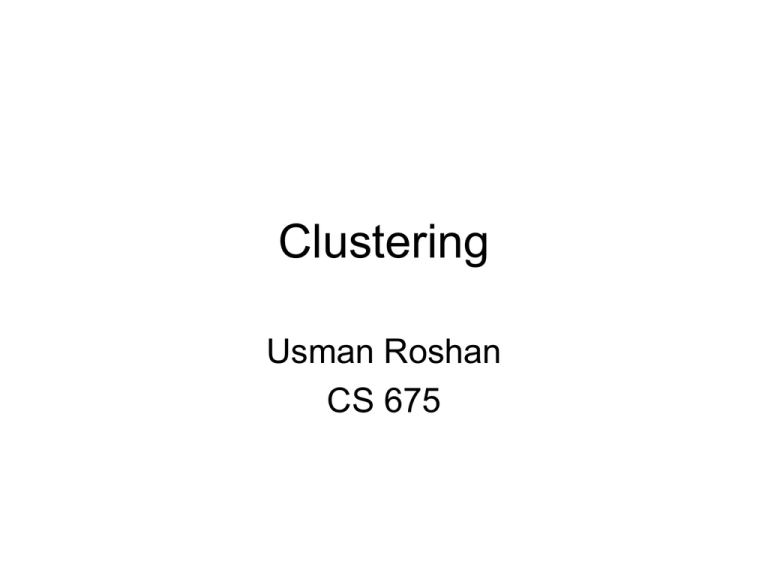
Clustering Usman Roshan CS 675 Clustering • Suppose we want to cluster n vectors in Rd into two groups. Define C1 and C2 as the two groups. • Our objective is to find C1 and C2 that minimize 2 2 å å|| x j - mi || i=1 x j ÎC i where mi is the mean of class Ci Clustering • NP hard even for 2-means • NP hard even on plane • K-means heuristic – Popular and hard to beat – Introduced in 1950s and 1960s K-means algorithm for two clusters d Input: xi R , i 1 Algorithm: 1. Initialize: assign xi to C1 or C2 with equal probability and compute means: 1 m1 = C1 2. 3. 4. n åx i x i ÎC1 1 m2 = C2 åx i x i ÎC 2 Recompute clusters: assign xi to C1 if ||xi-m1||<||xi-m2||, otherwise assign to C2 Recompute means m1 and m2 Compute objective 2 å å|| x 2 m || j i i=1 x j ÎC i 5. Compute objective of new clustering. If difference is smaller than then stop, otherwise go to step 2. d K-means • Is it guaranteed to find the clustering which optimizes the objective? • It is guaranteed to find a local optimal • We can prove that the objective decreases with subsequence iterations Proof sketch of convergence of k-means 2 å 2 || x m || å j i ³ 2 2 || x m || å j i ³ i=1 x j ÎC i å i=1 x j ÎC i* 2 å * 2 || x m å j i || i=1 x j ÎC i* Justification of first inequality: by assigning xj to the closest mean the objective decreases or stays the same Justification of second inequality: for a given cluster its mean minimizes squared error loss K-means clustering • K-means is the Expected-Maximization solution if we assume data is generated by Gaussian distribution – EM: Find clustering of data that maximizes likelihood – Unsupervised means no parameters given. Thus we iterate between estimating expected and actual values of parameters • PCA gives relaxed solution to k-means clustering. Sketch of proof: – Cast k-means clustering as maximization problem – Relax cluster indicator variables to be continuous and solution is given by PCA K-means clustering • K-medians variant: – Select cluster center that is the median – Has the effect of minimizing L1 error • K-medoid – Cluster center is an actual datapoint (not same as k-medians) • Algorithms similar to k-means • Similar local minima problems to kmeans Other clustering algorithms • Spherical k-means – Normalize each datapoint (set length to 1) – Clustering by finding center with minimum cosine angle to cluster points – Similar iterative algorithm to Euclidean kmeans – Converges with similar proofs. Other clustering algorithms • Hierarchical clustering – Initialize n clusters where each datapoint is in its own cluster – Merge two nearest clusters into one – Update distances of new cluster to existing ones – Repeat step 2 until k clusters are formed. Other clustering algorithms • Graph clustering (Spectral clustering) – Find cut of minimum cost in a bipartition of the data – NP-hard if look for minimum cut such that size of two clusters are similar – Relaxation leads to spectral clustering – Based on calculating Laplacian of a graph and eigenvalues and eigenvectors of similarity matrix Application on population structure data • Data are vectors xi where each feature takes on values 0, 1, and 2 to denote number of alleles of a particular single nucleotide polymorphism (SNP) • Output yi is an integer indicating the population group a vector belongs to Publicly available real data • Datasets (Noah Rosenberg’s lab): – East Asian admixture: 10 individuals from Cambodia, 15 from Siberia, 49 from China, and 16 from Japan; 459,188 SNPs – African admixture: 32 Biaka Pygmy individuals, 15 Mbuti Pygmy, 24 Mandenka, 25 Yoruba, 7 San from Namibia, 8 Bantu of South Africa, and 12 Bantu of Kenya; 454,732 SNPs – Middle Eastern admixture: contains 43 Druze from IsrailCarmel, 47 Bedouins from Israel-Negev, 26 Palestinians from Israel-Central, and 30 Mozabite from Algeria-Mzab; 438,596 SNPs East Asian populations African populations Middle Eastern populations K-means applied to PCA data • PCA and kernel PCA (poly degree 2) • K-means and spherical k-means • Number of clusters set to true value
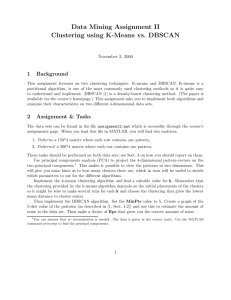

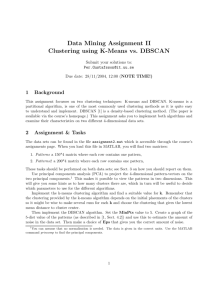
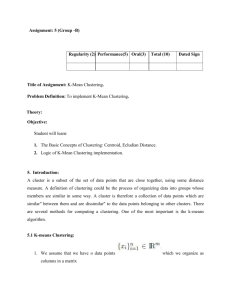


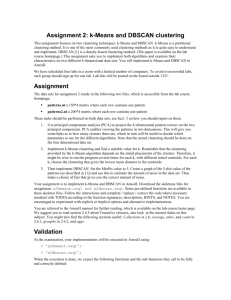

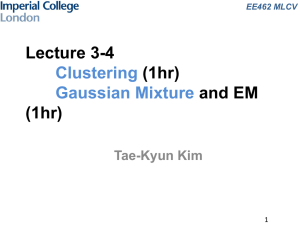
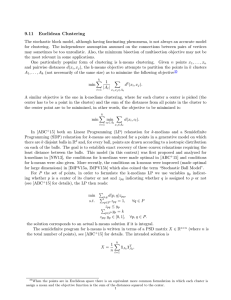
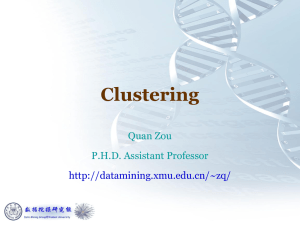
![[CLICK HERE AND TYPE TITLE]](http://s3.studylib.net/store/data/006660963_2-8793f3ec859ec6433cdc98aef1b3f9d3-300x300.png)